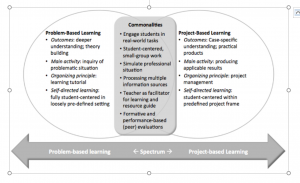27 Problem-based Learning and Case-based Learning
Teaching Strategies: Problem-based Learning and Case-based Learning
Problem-based learning
Problem-based learning, or PBL, in its purest form, presents a fully-formed “real-world” problem to students at the outset of a course. Students then experiment and explore to solve the problem, with the instructor acting as a “guide” in the process, offering correction, focus, and assistance to guide inquiry.
During class time, the students are presented with a problem or issue that needs to be solved using the information they are learning about. As a group, they decide what they already know about the subject, determine what they need to know to solve the problem, apply suggested solutions to the problem, and analyze the results.
The four basic questions of problem-based learning are:
- What do you know (about the topic/problem/issue)?
- What do you need to know to solve the problem?
- How do you get that information?
- How do you apply the information to solve the problem?
Case-based learning
Case-based learning and problem-based learning are instructional strategies that use the analysis of authentic, “real-life” scenarios or challenges as a means of demonstrating and/or building skills, competencies, and disciplinary intuition. Case-based learning tends to use cases as part of an integrated pedagogical strategy along with lectures, readings, and other instructional activities; once students have been presented with a theoretical framework they review a case and try to apply the principles to the case at hand, bridging theory and practice.
Quick Start Guide – PBL 101
Employing this strategy can be rewarding but takes careful planning to give your students the tools they need to solve the problem – we have created a planning document that walks you through the steps to creating a comprehensive lesson based on PBL, which can be found here: Problem-based instruction planning template.
Quick Start Guide – Case-based Learning 101
Employing this strategy can encourage critical thinking in students as they comprehensively analyze a case while connecting it to the content. To help you develop the most robust case-based lesson possible, ATS has created a planning document that walks you through the steps to creating a case-based lesson:
Variations
This section outlines how you might begin to think about adopting the aforementioned teaching strategies and the tools you might consider employing.
Problem-Based Learning
Project-based learning, also called PBL, uses extended projects such as problems, questions, or challenges to help students gain knowledge or explore information.

Case-based learning
- For those in education, the PELP framework is a useful tool to evaluate cases. Instructional Design Services has developed a PELP Framework Case Selection Guide and PELP Framework Activity Guide (for students)
- Games and simulations are a way to get students to think through case scenarios and to create logic chains.
- Case-based learning and problem-based learning do not need to be exclusive. Cases and scenarios can often be the basis for the problem in problem-based learning.
- Case studies from the National Center for Case Study Teaching in Science
- A Journal of Teaching Cases in Public Administration and Public Policy, University of Washington
- Real-life cases can often be found in newspapers, journals, and social media sites. College of Business faculty have access to real-life scenarios from the Wall Street Journal. Instructional Design Services has created a WSJ Instruction Template to walk you through using the Wall Street Journal in your lesson.
In the Library
Allen, D. E., Donham, R. S., & Bernhardt, S. A. (2011). Problem-based learning. New Directions For Teaching & Learning, 2011(128), 21-29. doi:10.1002/tl.465
Amador, J., Miles, L., & Peters, C.B. (2006). The Practice of Problem-Based Learning: A Guide to Implementing PBL in the College Classroom. Boston, MA: Anker Publishing Company.
Crowther, B. (2002). Problem-based learning: Case studies. International Journal of Electrical Engineering Education, 39(1), 87.
Dolmans, D., De Grave, W., Wolfhagen, I., & Van der Vleuten, C.P. (2005). Problem-based learning: future challenges for educational practice and research. Medical Education, 39(7), 732-741.
Hale, S. (2006). Politics and the real world: A case study in developing case-based learning. European Political Science, 5(1), 84-96. doi:10.1057/palgrave.eps.2210060
Klenk, M., Aha, D. W., & Molineaux, M. (2011). The case for case-based transfer learning. AI Magazine, 32(1), 54.
Yew, E., Chng, E., & Schmidt, H. (2011). Is learning in problem-based learning cumulative? Advances In Health Sciences Education: Theory And Practice, 16(4), 449-464. doi:10.1007/s10459-010-9267-y1MrJanzen1984. (Creator). (2016, August 02).Problem Based Learning vs Project-Based Learning [digital image]. https://commons.wikimedia.org/wiki/File:Problem_Based_Learning_vs_Project_Based_Learning.png#file

